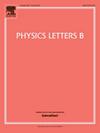Ab initio calculation of the 3He(α,γ)7Be astrophysical S factor with chiral two- and three-nucleon forces
IF 4.3
2区 物理与天体物理
Q1 ASTRONOMY & ASTROPHYSICS
引用次数: 0
Abstract
The 3HeBe radiative capture reaction plays a key role in the creation of elements in stars as well as in the production of solar neutrinos, the observation of which is one of the main tools to study the properties of our sun. Since accurate experimental measurements of this fusion cross section at solar energies are difficult due to the strong Coulomb repulsion between the reactants, the onus falls on theory to provide a robust means for extrapolating from the region where experimental data is available down to the desired astrophysical regime. We present the first microscopic calculations of 3HeBe with explicit inclusion of three-nucleon forces. Our prediction of the astrophysical S factor qualitatively agrees with experimental data. We further incorporate experimental bound-state and scattering information in our calculation to arrive at a more quantitative description. This process reveals that our current model lacks sufficient repulsion in the channel of our model space to simultaneously reproduce elastic-scattering data. This deficit suggests that 3HeBe probes aspects of the nuclear force that are not currently well-constrained.
利用手性二核力和三核力对 3He(α,γ)7Be 天体 S 因子的 Ab initio 计算
3He(α,γ)7Be辐射俘获反应在恒星元素的形成以及太阳中微子的产生中起着关键作用,对中微子的观测是研究太阳性质的主要工具之一。由于反应物之间强烈的库仑斥力,对太阳能量下的聚变横截面进行精确的实验测量是困难的,因此理论的责任在于提供一种可靠的方法,从实验数据可用的区域推断出所需的天体物理状态。我们提出了第一个包含三核子力的3He(α,γ)7Be的微观计算。我们对天体物理S因子的预测定性地与实验数据一致。我们进一步将实验束缚态和散射信息纳入我们的计算中,以获得更定量的描述。这一过程表明,我们目前的模型在模型空间的1/2+通道中缺乏足够的斥力来同时再现弹性散射数据。这一缺陷表明3He(α,γ)7Be探测了核力的一些方面,而这些方面目前还没有得到很好的约束。
本文章由计算机程序翻译,如有差异,请以英文原文为准。
求助全文
约1分钟内获得全文
求助全文
来源期刊

Physics Letters B
物理-物理:综合
CiteScore
9.10
自引率
6.80%
发文量
647
审稿时长
3 months
期刊介绍:
Physics Letters B ensures the rapid publication of important new results in particle physics, nuclear physics and cosmology. Specialized editors are responsible for contributions in experimental nuclear physics, theoretical nuclear physics, experimental high-energy physics, theoretical high-energy physics, and astrophysics.
 求助内容:
求助内容: 应助结果提醒方式:
应助结果提醒方式:


